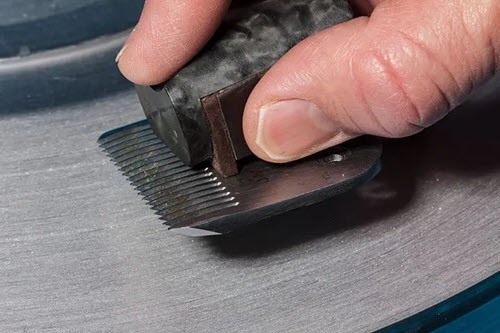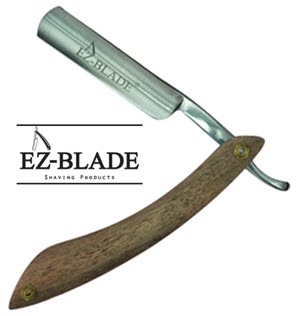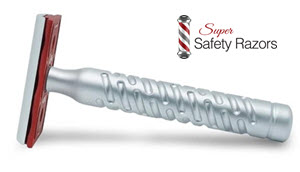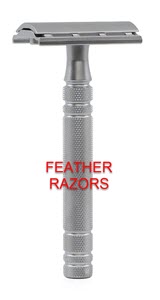How To Sharpen Electric Razor Blades: Quick Guide
How to Sharpen Electric Razor Blades: A Step-by-Step Guide

Electric razors are convenient tools for personal grooming, but their blades can become dull over time, affecting their performance. Sharpening the blades of your electric razor is an effective way to prolong its life and ensure a close, comfortable shave. This article provides a step-by-step guide on sharpening electric razor blades, helping you maintain your device at peak performance.
Step 1: Gather Your Materials
To begin sharpening your electric razor blades, you will need a few essential items:
- A small brush or toothbrush
- Blade lubricant or mineral oil
- A piece of 3000- to 6000-grit wet/dry sandpaper
- A flat surface
Step 2: Clean the Razor Blades
Cleaning the blades to remove debris, hair, or buildup is crucial before sharpening. Disassemble your razor according to the manufacturer’s instructions. Use a brush or toothbrush to clean the blades and surrounding areas gently. This ensures a more effective sharpening process.
Step 3: Lubricate the Blades
Apply a small amount of blade lubricant or mineral oil to the blades. It reduces friction during sharpening and protects the blades from potential damage.
Step 4: Prepare the Sandpaper
Place the wet/dry sandpaper on a flat surface. The higher the grit, the finer the sharpening will be. A 3000- to 6000-grit sandpaper is usually sufficient for electric razor blades.
Step 5: Sharpen the Blades
Gently run the razor blades over the sandpaper in one direction. Avoid applying too much pressure, as this could damage the blades. Repeat this process several times, ensuring you cover all parts of the blade evenly. The goal is to lightly grind down any rough edges or burrs that have formed on the blade’s surface.
Step 6: Reassemble and Test Your Razor
Once you’ve finished sharpening, reassemble your razor according to the manufacturer’s instructions. Test the razor on a small area of the skin to ensure it works properly and provides a smooth shave.
Step 7: Regular Maintenance
To keep your electric razor in top condition, clean and sharpen the blades regularly. The frequency of sharpening will depend on how often you use the razor, but it’s generally recommended that it be done every few months.
Sharpening your electric razor blades is a simple and effective way to extend the life of your razor and ensure a better shaving experience. With the right tools and a little patience, you can maintain your razor’s performance and avoid the cost of frequent replacements. Always follow the manufacturer’s instructions and take care when handling razor blades to prevent injury.
Safety Tips for Blade Sharpening and Handling: Essential Precautions for Injury Prevention
Sharpening electric razor blades involves handling sharp objects, which can pose a risk of injury. Following safety guidelines to prevent accidents during the sharpening process is crucial. This guide offers essential safety tips for sharpening and handling electric razor blades.
1. Prepare Your Work Area
- Well-Lit Space: Ensure your workspace is well-lit so you can see what you’re doing.
- Stable Surface: Use a flat surface to avoid accidental slips or movements while sharpening.
- Keep Away from Children and Pets: Ensure that children and pets are not in the vicinity to avoid distractions and potential accidents.
2. Wear Protective Gear
- Gloves: Wear cut resistant gloves to protect your hands from accidental cuts.
- Eye Protection: Use safety glasses to shield your eyes from small metal filings or debris.
3. Handle Blades Carefully
- Gentle Handling: Handle the blades gently and avoid rushing. Sudden movements can lead to slips and cuts.
- Firm Grip: Hold the razor and blades securely but without excessive force to maintain control during sharpening.
4. Use Proper Tools and Techniques
- Correct Sharpening Tools: Use the appropriate sharpening tools, such as fine-grit sandpaper or a sharpening stone designed for small blades.
- Follow Instructions: If you’re using a sharpening kit or tool, follow the manufacturer’s instructions carefully.
- Consistent Angles: Maintain a sharpening angle to avoid uneven edges or blade damage.
5. Disassemble and Reassemble with Caution
- Follow the Manufacturer’s Guide: Carefully follow the manufacturer’s instructions for disassembling and reassembling your razor.
- Avoid Forcing Components: Never force parts to come apart or back together, as this can lead to broken pieces or injury.
6. Keep Blades Away from the Body
- Safe Direction: Always sharpen and handle blades with the sharp edge facing away from your body.
- Focused Attention: Stay focused on the task and avoid distractions to prevent accidental slips or cuts.
7. Clean Up After Sharpening
- Dispose of Debris: Safely dispose of any metal filings or debris produced during sharpening.
- Store Tools Safely: Keep your sharpening tools safe and out of reach of children and pets.
8. Know First Aid
- Be Prepared: Familiarize yourself with basic first aid for cuts in case of an accident.
- Immediate Action: If you get cut, apply pressure to the wound and seek medical attention if necessary.
Following these safety tips for blade sharpening and handling is crucial to prevent injuries. Always work in a well-prepared environment, use the proper tools and techniques, and stay focused and cautious throughout the process. Safety is always your top priority when maintaining and sharpening electric razor blades.
Maintenance and Care of Electric Razors: Essential Tips for Optimal Performance
Proper maintenance and care of electric razors are vital to ensuring their longevity and optimal performance. Regular cleaning, lubrication, and appropriate storage not only extend the life of your razor but also provide a better shaving experience. Here are some essential tips to help you maintain your electric razor effectively.
1. Regular Cleaning
- After Each Use: It’s essential to clean your electric razor after every shave. Gently tap the razor’s head to remove loose hairs and skin particles. Many models come with a small brush designed explicitly for this purpose.
- Deep Cleaning: Periodically, a more thorough cleaning is required. Depending on the model, you might need to disassemble the head or remove the blades. Use the cleaning brush to remove all hair and debris. Some razors can be rinsed under running water, but always check the manufacturer’s instructions first.
2. Lubrication
- Frequency: Lubricating the blades and moving parts of your electric razor helps reduce friction, which can wear down the components over time. Lubricate the blades every few months or more frequently if you use your razor daily.
- Type of Lubricant: Use a lubricant specifically designed for electric razors or a light mineral oil. Avoid heavy oils, as they can gum up the moving parts.
- Application: Apply a small amount of lubricant to the blades and moving parts. Turn on the razor for a few seconds to distribute the oil evenly.
3. Proper Storage
- Storage Location: Store your electric razor in a dry, cool place. Avoid leaving it in humid areas like bathrooms for prolonged exposure to moisture, which can damage the razor.
- Protective Cover: Use a protective cover or store your razor in a case to protect it from dust and accidental damage. It is essential for travel.
4. Battery Care
- Charging: For rechargeable models, follow the manufacturer’s instructions regarding charging. Overcharging can reduce battery life while letting it run too flat can also be detrimental.
- Replacement: If your razor has a replaceable battery, replace it as needed to ensure consistent performance.
5. Replacing Parts
- Blades and Foils: Your razor’s blades and foils will wear out over time. Replace them according to the manufacturer’s recommendations or when you notice a decline in cutting.
6. Avoid Drops and Impacts
- Handling: Be careful not to drop or knock your electric razor, as this can damage the blades and internal components.
By following these maintenance and care tips, you can significantly extend the life of your electric razor and ensure it provides a close, comfortable shave every time. Regular cleaning, proper lubrication, and thoughtful storage go a long way in preserving the quality and functionality of your shaving tool.
Understanding Razor Blade Types and Materials: A Comprehensive Guide
Electric razors come in various designs, each with different blades and materials. Understanding these differences is crucial for proper maintenance and choosing a razor that best suits your needs. This guide elaborates on the standard blades used in electric razors, such as foil and rotary blades, and the materials they’re made from.
1. Foil Blades
- Design: Foil razors have straight heads with a thin layer of metal, known as a foil, covering oscillating blades. The foil has tiny perforations that capture hair and guide it to the blades.
- Suitability: Foil razors are ideal for those who shave daily and have fine or straight hair. They are known for providing a very close shave and are best used in straight, back-and-forth motions.
- Material: The blades are typically made of stainless steel, which is durable and rust-resistant. The foil is also usually stainless steel but is thinner and more delicate.
2. Rotary Blades
- Design: Rotary razors feature circular blades mounted in a triangular or quadrangular pattern. These blades spin and flex to adapt to the contours of the face.
- Suitability: Rotary razors are well-suited for those with coarse or thick hair and individuals who don’t shave daily. They excel at navigating around contours and are best used with circular motions.
- Material: Like foil razors, the blades are often stainless steel, and the housing for the rotary blades is usually durable plastic.
3. Blade Materials
- Stainless Steel: Most electric razor blades are made from stainless steel due to their durability, corrosion resistance, and ability to maintain a sharp edge.
- Titanium Coating: Some higher-end models feature blades with a titanium coating. Titanium is lightweight and extremely strong, providing additional durability and a sharper edge for longer.
4. Maintenance Needs
- Cleaning: Regardless of the type, foil and rotary blades require regular cleaning to remove hair, skin oils, and other debris. It ensures optimal performance and extends the life of the blades.
- Lubrication: Both razors benefit from periodic lubrication to reduce friction and wear on the blades.
- Replacement: Over time, the blades will dull and require replacement. The replacement frequency depends on the razor’s make and model and the user’s shaving habits.
5. Considerations for Selection
- Skin Type and Hair: When choosing foil and rotary razors, consider your skin type and texture. Foil razors are typically better for sensitive skin, while rotary razors are better for tougher skin and coarser hair.
- Shaving Habits: Your shaving frequency and preferred style (e.g., clean-shaven, stubble) can also influence your choice.
Understanding the types of blades and materials used in electric razors can help you make an informed decision when purchasing a razor and ensure its proper maintenance. Whether you choose a foil or rotary razor, knowing how to care for it will enhance your shaving experience and extend the life of your device.
Replacement vs. Sharpening: Navigating the Decision for Optimal Electric Razor Performance
Electric razor users often face a dilemma when deciding whether to sharpen or replace their blades. Understanding the signs of wear and tear and knowing when each option is appropriate can help maintain the razor’s effectiveness and prolong its life. This guide provides insights into the replacement versus sharpening decision.
1. Signs of Wear and Tear
- Dull Blades: If your razor is not providing as close a shave as before, or you must go over the same area multiple times, it could be a sign of dull blades.
- Increased Skin Irritation: This can be caused by dull blades that can tug at hair rather than cutting cleanly, leading to increased skin irritation and discomfort.
- Visible Damage: Look for any visible nicks, bends, or blunting on the blades. If the blades appear physically damaged, they likely need replacing.
- Increased Noise or Vibration: If your razor is noisier or vibrates more than usual, it could indicate that the blades are worn out and struggling to perform efficiently.
2. When to Sharpen Blades
- Minor Dullness: If the blades are only slightly dull and there’s no visible damage, sharpening can be an excellent option to restore their cutting efficiency.
- Regular Maintenance: Regular sharpening as part of your maintenance routine can extend the life of the blades and delay the need for replacement.
- Cost-Effective Solution: Sharpening is generally more cost-effective than purchasing new blades, especially if the blades are made of high-quality material.
3. When to Replace Blades
- Visible Damage: If the blades are visibly damaged, bent, or severely dulled, replacement is the best option.
- Long-Term Use: Blades can only be sharpened a limited number of times before their structural integrity is compromised. If you’ve sharpened the blades several times already, it may be time to replace them.
- Poor Performance Post-Sharpening: If sharpening does not improve the shave quality, the blades are likely too worn and need replacing.
- Manufacturer Recommendations: Follow the manufacturer’s guidelines on blade replacement intervals, as each model may have specific requirements.
4. Considerations for Replacement
- Compatibility: Ensure the replacement blades are compatible with your specific electric razor model.
- Quality: Opt for high-quality replacement blades to ensure the best performance and durability.
- Cost: Consider replacing blades rather than buying a new razor, especially if your current model is old or has other issues.
5. Sharpening Techniques
- Manual Sharpening: This involves using a sharpening stone or fine-grit sandpaper. It requires precision and care to avoid damaging the blades.
- Professional Sharpening: Some users opt to have their blades professionally sharpened for optimal results.
Conclusion
Deciding between sharpening and replacing electric razor blades depends on each option’s condition, performance, and cost-effectiveness. Regular maintenance, including timely sharpening and replacement, will ensure that your electric razor continues to provide a smooth, comfortable shave. Always consider the manufacturer’s guidelines and the specific needs of your razor model.
- Bakblade 2.0: The Best Back Shaver for Men
- Ball Shaver That Won’t Cut You
- Shaving Gel: What to Know About!
- Henson Shaving: Where Design Meets Durability and Performance
- Caramel Honey Blonde Hair: Elevate Your Look
- Feather Razors: Precision Shaving for Every Skin Type
- Straight Razor Shaving: Unlocking a Closer, Smoother Shave
- Premium Safety Razors: Your Guide to Quality Shave
- Pros & Cons: Shaving Against the Grain Guide
- Maximize Your Shave: Norelco Sensotouch 3d Razor



